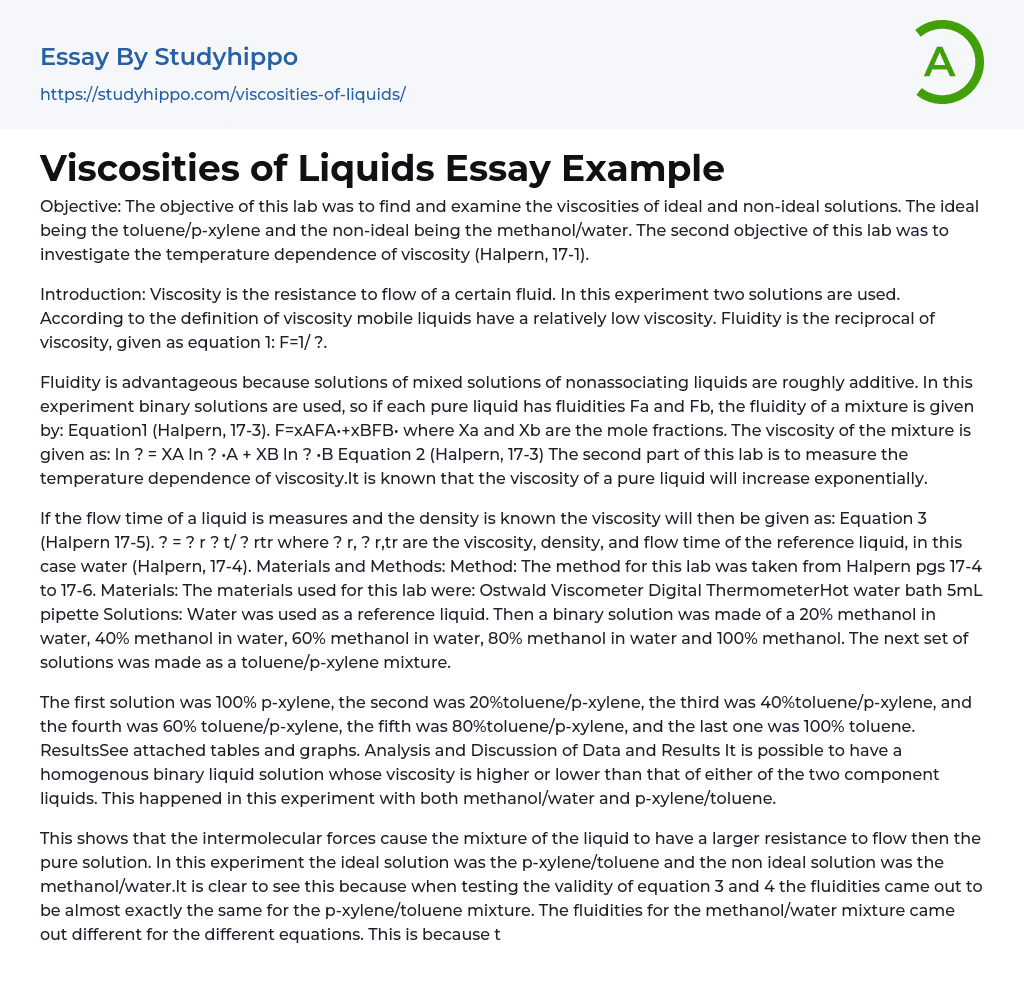Objective: The objective of this lab was to find and examine the viscosities of ideal and non-ideal solutions. The ideal being the toluene/p-xylene and the non-ideal being the methanol/water. The second objective of this lab was to investigate the temperature dependence of viscosity (Halpern, 17-1).
Introduction: Viscosity is the resistance to flow of a certain fluid. In this experiment two solutions are used. According to the definition of viscosity mobile liquids have a relatively low viscosity. Fluidity is the reciprocal of viscosity, given as equation 1: F=1/ ?.
Fluidity is advantageous because solutions of mixed solutions of nonassociating liquids are roughly additive. In this experiment binary solutions are used, so if each pure liquid has fluidities Fa and Fb, the fluidity of a mixture is given
...by: Equation1 (Halpern, 17-3). F=xAFA•+xBFB• where Xa and Xb are the mole fractions. The viscosity of the mixture is given as: ln ? = XA ln ? •A + XB ln ? •B Equation 2 (Halpern, 17-3) The second part of this lab is to measure the temperature dependence of viscosity.It is known that the viscosity of a pure liquid will increase exponentially.
If the flow time of a liquid is measures and the density is known the viscosity will then be given as: Equation 3 (Halpern 17-5). ? = ? r ? t/ ? rtr where ? r, ? r,tr are the viscosity, density, and flow time of the reference liquid, in this case water (Halpern, 17-4). Materials and Methods: Method: The method for this lab was taken from Halpern pgs 17-4 to 17-6. Materials: The materials used for this lab were: Ostwald Viscometer Digital ThermometerHot water bath 5m
pipette Solutions: Water was used as a reference liquid. Then a binary solution was made of a 20% methanol in water, 40% methanol in water, 60% methanol in water, 80% methanol in water and 100% methanol. The next set of solutions was made as a toluene/p-xylene mixture.
The first solution was 100% p-xylene, the second was 20%toluene/p-xylene, the third was 40%toluene/p-xylene, and the fourth was 60% toluene/p-xylene, the fifth was 80%toluene/p-xylene, and the last one was 100% toluene. ResultsSee attached tables and graphs. Analysis and Discussion of Data and Results It is possible to have a homogenous binary liquid solution whose viscosity is higher or lower than that of either of the two component liquids. This happened in this experiment with both methanol/water and p-xylene/toluene.
This shows that the intermolecular forces cause the mixture of the liquid to have a larger resistance to flow then the pure solution. In this experiment the ideal solution was the p-xylene/toluene and the non ideal solution was the methanol/water.It is clear to see this because when testing the validity of equation 3 and 4 the fluidities came out to be almost exactly the same for the p-xylene/toluene mixture. The fluidities for the methanol/water mixture came out different for the different equations. This is because this was not an ideal mixture. The known value of p-xylene and the measured value of p-xylene were fairly close.
The known value of the viscosity of p-xylene was 0. 6475 mPa s. The measured value of the viscosity of p-xylene was 0. 25 mPa s.
The known and measure viscosities of methanol were also very close. The known value was 0. 59 mPa s.
The measured value was 0. 594. The known and measured viscosities of toluene were also very close.
The known value was 0. 590. The measured value was 0. 580.
This shows that the calculations were done correctly and the experiment went well. Works Cited. Halpern, Arthur M. ; McBane, George C. ; Experimental Physical Chemistry: A Laboratory Textbook, 3rd ed.
; W. H. Freeman and Company. : New York, 2006.
- Organic Chemistry essays
- Acid essays
- Calcium essays
- Chemical Bond essays
- Chemical Reaction essays
- Chromatography essays
- Ethanol essays
- Hydrogen essays
- Periodic Table essays
- Titration essays
- Chemical reactions essays
- Osmosis essays
- Carbohydrate essays
- Carbon essays
- Ph essays
- Diffusion essays
- Copper essays
- Salt essays
- Concentration essays
- Sodium essays
- Distillation essays
- Amylase essays
- Magnesium essays
- Acid Rain essays
- Agriculture essays
- Albert einstein essays
- Animals essays
- Archaeology essays
- Bear essays
- Biology essays
- Birds essays
- Butterfly essays
- Cat essays
- Charles Darwin essays
- Chemistry essays
- Dinosaur essays
- Discovery essays
- Dolphin essays
- Elephant essays
- Eli Whitney essays
- Environmental Science essays
- Evolution essays
- Fish essays
- Genetics essays
- Horse essays
- Human Evolution essays
- Isaac Newton essays
- Journal essays
- Linguistics essays
- Lion essays




